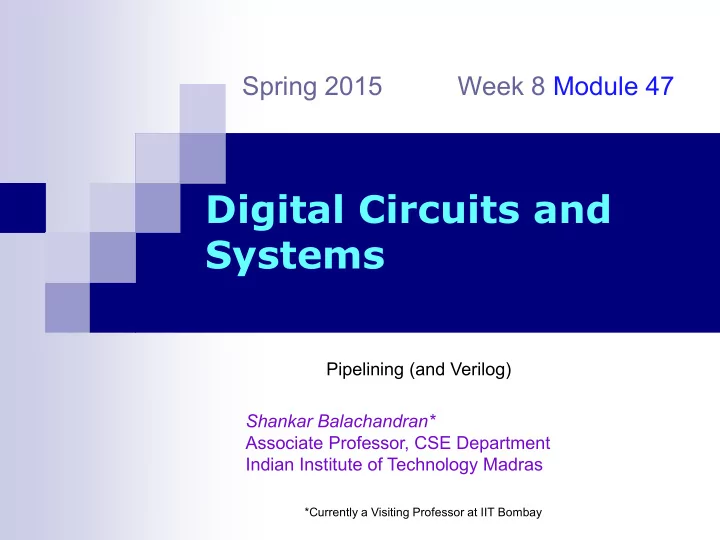

Spring 2015 Week 8 Module 47 Digital Circuits and Systems Pipelining (and Verilog) Shankar Balachandran* Associate Professor, CSE Department Indian Institute of Technology Madras *Currently a Visiting Professor at IIT Bombay
Dataflow Modeling GCD algorithm No abstract constructs (for loops) were used Loops were unrolled Basic computing structure was identified Sequence in which the data was supplied and written back was taken care of by a separate control (state machine) Machine had a distinct “Control Path” and a “Data Path” Widely known by the name Register Transfer Level Design, RTL for short
Characteristics of RTL Design Perfect balance of abstraction vs structure Wires and Regs are declared, representing connectivity in the circuit Verilog statements imply datapath and registers Multiplexers and Buses are identified Clocking mechanism for registers is identified Register widths are identified
Dataflow Example input [3:0] a,b; input [7:0] c; wire [7:0] d; --a, b and c arrive at the same time assign d = a*b + c; a Purely Combinational d b c
Registered Output - Blocking a always @(a,b) begin ab = a * b; d b end c always @(posedge clk) CLK d <= ab + c; Equivalent to d = a[i]*b[i] + c[i];
Implications a d b Addition and Multiplication operation are c CLK cascaded The maximum delay through the combinational logic is T ADD +T MULT After the delay the register can latch the data Meanwhile the input must remain unchanged Next input can be given only after the delay T ADD +T MULT and thus clock should be as wide as the sum of the delays The operation takes one clock cycle and you can perform one operation every clock cycle
Model with Nonblocking always @(posedge clk) begin d <= a*b + c; end Infers the same hardware as previous one
Mode with Nonblocking(2) always @(posedge clk) begin ab <= a * b; d <= ab + c; end
Hardware Inference a ab d b c
Why? Register for ab Assigned inside a clock statement Register for d Also within a clock statement
Problem with the Model Multiplier works on current a and b The result will be available only after one clock cycle Adder works on current c and previous ab The equivalent C code : d = a[i-1]*b[i-1] + c[i];
From Simulation Point of View ab is a nonblocking assignment Not updated till a new timing control d uses the value of ab Value of ab not updated immediately Reg ab has memory Thus previous value is used Simulation and Synthesis are consistent
Another Verilog Model always @(posedge clk) begin ab <= a * b; ctmp <= c; d <= ab + ctmp; end
Hardware Inferred a ab d b c ctmp
Analysis of the Model New reg ctmp copies c All the regs ab, ctmp and d get a register When ab is computed, c is just copied to ctmp Adder always looks at the previous value of ab and ctmp (previous data) All data inputs pass through same number of registers and hence consistent results Equivalent C code : d = a[i-1]*b[i-1] + c[i-1];
From Simulation Point of View ab is assigned only at the end ctmp is also assigned only at the end Both ab and ctmp are regs and thus retain the old value d looks at the values of ab and ctmp from the previous assignment Consistent with the synthesis model
More Analysis Unlike the model with blocking assignments, results are not available immediately. They are delayed by one clock cycle. The clock can now be max (T ADD ,T MULT ) instead of T ADD +T MULT Faster clock You can supply data, once every clock cycle You get the results once every clock cycle (except for the very first data)
Pipelining Note that when the multiplier is working on the Current Set , the adder is evaluating result from the previous set Thus, the datapath elements are working in tandem. This is called pipelining Data marches through the operations at the command of a clock Pipelining is facilitated by many small combinational blocks which work in tandem and the registers between them which separate the data set
Illustration of a Pipelined System TB TA T A +T B Pipelined Version max (T A ,T B )
Discussion on Pipelined Systems Better delay Clocks can be made faster because the critical path for computation is reduced Faster pipeline clocks can be used with slower system clocks to achieve unit cycle operations Latency is the cost of using the pipeline Results are available only after so many clock cycles More number of latches in the pipelined system than in the original one Parallel Processing is another alternative to achieve the same thing At the expense of huge amounts of hardware
Implications of Latency and Throughput Latency is an important factor in microprocessors etc Most of the operations need to be completed within one clock cycle and results be immediately available Control is simpler because only one data set is current at any time Throughput is more important in DSP applications Real time data need to be acquired and processed Latency is not an issue
Example of Pipelining - Convolution Popular in DSP width Defn : c a [ i ] * b [ i ] i 0 a – The set of coefficients for convolution b – Sample set c – Result width – Sample window size The sample set B is a moving window and can be arriving real time
Regular Implementation B T A +T B a[0] a[1] C a[2] a[3]
Pipelined Implementation always @(posedge clk) begin ab <= a * b; ctmp <= ab + ctmp; end c <= ctmp;
Implied Hardware A AB C CTMP B Circular Buffer Holding Samples Equivalent C code : c = c + a[i]*b[i];
End of Week 8: Module 47 Thank You Pipeliing (Verilog) 26
Recommend
More recommend